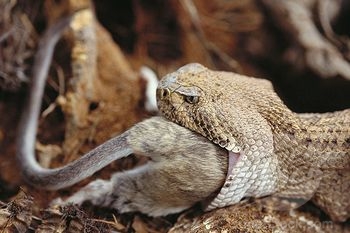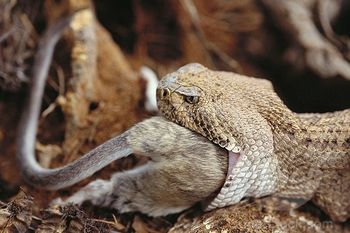Western diamondback rattlesnakes are one of the most iconic and feared snakes in North America. They are renowned for their venomous bite and their distinctive rattle, which warns potential predators to stay away. But have you ever wondered what these snakes eat to survive in the harsh desert environment?
Although western diamondback rattlesnakes are carnivores, they are not picky eaters and will consume a wide variety of prey. From small rodents to larger mammals, their diet is diverse and fascinating. So, let’s delve into the world of western diamondback rattlesnakes and explore their eating habits in detail.
Western Diamondback Rattlesnakes are carnivores and typically eat small mammals like rodents, rabbits, and birds. They also consume lizards, frogs, and other snakes, including their own kind. These snakes have venom that helps them to kill prey quickly before swallowing it whole.

What Do Western Diamondback Rattlesnakes Eat?
Western Diamondback Rattlesnakes are one of the most iconic and feared species of snake in North America. They are known for their distinctive diamond-shaped pattern on their backs and their intimidating rattle sound. But have you ever wondered what these venomous creatures eat? In this article, we will explore the diet of the Western Diamondback Rattlesnake.
The Diet of Western Diamondback Rattlesnakes
Western Diamondback Rattlesnakes are carnivorous, which means that they feed exclusively on other animals. They are opportunistic predators, meaning that they will eat any animal they can overpower and consume. Their diet includes small mammals, birds, lizards, and even other snakes.
When hunting, Western Diamondback Rattlesnakes use their keen sense of smell and excellent camouflage to ambush their prey. They will wait patiently for their prey to come within striking distance before they attack. Once they have bitten their prey, they will use their powerful muscles to constrict and suffocate it.
Small Mammals
Small mammals such as mice, rats, and rabbits are a significant part of the Western Diamondback Rattlesnake’s diet. They are easy to catch, and their high energy content makes them an ideal food source. These snakes are known to consume up to 50% of their body weight in a single meal, which means that they can go for weeks without eating again.
Benefits of Eating Small Mammals
Small mammals are not only a good source of energy, but they also provide essential nutrients such as proteins and fats. These nutrients are required for growth, maintenance, and repair of the snake’s body tissues. Additionally, small mammals are abundant in the Western Diamondback Rattlesnake’s habitat, which means that they are readily available.
Vs
However, there are also some risks associated with consuming small mammals. For example, these animals may carry diseases or parasites that can be harmful to the snake. Additionally, hunting small mammals requires a lot of energy, which can be challenging for the snake, especially during the winter months when food is scarce.
Birds
Birds are another common prey item for Western Diamondback Rattlesnakes. These snakes are known to consume a variety of birds, including quails, doves, and even small owls. They will usually wait for the bird to land on the ground before they strike.
Benefits of Eating Birds
Birds are an excellent source of protein and other nutrients that are essential for the snake’s survival. Additionally, hunting birds requires less energy than hunting small mammals, which means that the snake can conserve energy.
Vs
However, hunting birds can be challenging because they are fast and agile. Additionally, birds are not as abundant as small mammals in the Western Diamondback Rattlesnake’s habitat, which means that they are not always available.
Lizards
Lizards are also a significant part of the Western Diamondback Rattlesnake’s diet. These snakes will consume a variety of lizards, including geckos, anoles, and skinks. They will usually wait for the lizard to come within striking distance before they attack.
Benefits of Eating Lizards
Lizards are an excellent source of protein and other essential nutrients. Additionally, they are abundant in the Western Diamondback Rattlesnake’s habitat, which means that they are readily available.
Vs
However, hunting lizards can be challenging because they are fast and agile. Additionally, lizards are not as energy-dense as small mammals, which means that the snake may need to consume more of them to meet its energy requirements.
Other Snakes
Western Diamondback Rattlesnakes are also known to consume other snakes, including other venomous species. This behavior is known as cannibalism.
Benefits of Eating Other Snakes
Eating other snakes can provide the Western Diamondback Rattlesnake with a considerable amount of energy and nutrients. Additionally, consuming other venomous snakes can help reduce competition for food and habitat.
Vs
However, consuming other snakes can be risky because they may be more challenging to overpower and may fight back. Additionally, consuming venomous snakes can be dangerous, as their venom may be lethal to the Western Diamondback Rattlesnake.
Conclusion
In conclusion, the Western Diamondback Rattlesnake is a carnivorous predator that feeds on a variety of small mammals, birds, lizards, and even other snakes. Each of these prey items has its own benefits and challenges, and the Western Diamondback Rattlesnake must use its hunting skills and instincts to survive in its habitat. Understanding the diet of these fascinating creatures can help us appreciate their role in the ecosystem and how we can coexist with them.
Frequently Asked Questions
Western Diamondback Rattlesnakes are fascinating creatures that can be found in many parts of the United States. One of the most common questions people have is, “What do Western Diamondback Rattlesnakes eat?” Here are five questions and answers that will help you understand their diet.
What is the diet of a Western Diamondback Rattlesnake?
As carnivores, Western Diamondback Rattlesnakes primarily eat small mammals such as mice, rats, and rabbits. They also eat birds, lizards, and other snakes. Their diet can vary depending on their location and the availability of prey.
Western Diamondback Rattlesnakes are ambush predators and use their venomous bite to immobilize their prey. They have heat-sensing pits that allow them to detect their prey’s body heat in the dark.
How often do Western Diamondback Rattlesnakes eat?
Western Diamondback Rattlesnakes do not need to eat very often. Depending on the size of their last meal, they can go several weeks or even months without eating. This is because they have a slow metabolism and can conserve energy for long periods of time.
When they do eat, Western Diamondback Rattlesnakes can consume prey that is up to 50% of their own body weight. After a large meal, they may rest for several days while their digestive system breaks down and absorbs the nutrients from their food.
Do Western Diamondback Rattlesnakes eat insects?
No, Western Diamondback Rattlesnakes do not eat insects. They are carnivores and primarily eat small mammals, birds, lizards, and other snakes. Their diet is limited to animals that they can swallow whole or in large pieces.
While they do not eat insects, Western Diamondback Rattlesnakes are important predators in their ecosystem and help to control populations of rodents and other small mammals.
Can Western Diamondback Rattlesnakes eat humans?
While Western Diamondback Rattlesnakes are venomous and can be dangerous to humans, they do not see humans as prey. They will only attack if they feel threatened or cornered.
If you encounter a Western Diamondback Rattlesnake in the wild, it is important to give it plenty of space and avoid approaching it. If you are bitten, seek medical attention immediately.
How do Western Diamondback Rattlesnakes catch their prey?
Western Diamondback Rattlesnakes are ambush predators and use their venomous bite to immobilize their prey. They have heat-sensing pits that allow them to detect their prey’s body heat in the dark.
Once they have located their prey, Western Diamondback Rattlesnakes will strike quickly and inject venom into their victim. They will then wait for their prey to weaken before swallowing it whole or in large pieces.
In conclusion, Western Diamondback Rattlesnakes are fascinating creatures that play an important role in the ecosystem. Their diet consists of a wide variety of prey, including rodents, lizards, birds, and even other snakes. These snakes have a unique hunting technique that involves ambushing their prey and injecting venom to immobilize it.
Despite their dangerous reputation, Western Diamondback Rattlesnakes play an essential role in controlling rodent populations, which can cause damage to crops and spread disease. They are also an important food source for other predators in the food chain.
Overall, learning about the eating habits of Western Diamondback Rattlesnakes can help us better understand and appreciate these magnificent creatures. As we continue to study and protect them, we can ensure their survival for generations to come.


